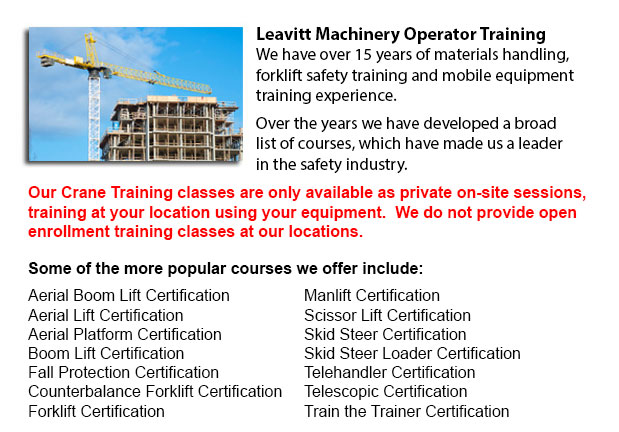
Kitchener Crane Certification - The Crane Certification Program consists of the industry recommended content that will teach the efficient and safe operation of cranes. The person will train in the following: how to identify cranes and their component parts; pre-operational, operational and post-operating requirements; rigging components and inspection/rejection criteria; how to determine overall lift capacity; and requirements specific to the work place where the trainees will be working.
Pre-operational requirements comprise assigning authority for the pre-operational check; doing the sequential pre-operational check based on the manufacturer's specifications or specifications certified by a professional engineer; checking the work area for obstacles and hazards; checking the log book for comments; checking cables, hooks, chains crane movement and safety latches; ensuring the proper functioning of operational controls; and knowing how to make sure that the crane's disconnect switch/isolator is properly working.
Operational requirements comprise identifying roles and responsibilities, and determining the requirement for a formal lift plan. Trainees would be taught how to carry out a hazard assessment related to environmental conditions, physical conditions and staff. Subject matter comprises determining when to seek competent assistance, the destination of loads and the safest route, and load weight and centre of gravity.
Individuals training should be able to identify an over-capacity lift, in addition to be able to choose appropriate rigging machine, select load limitations, and to determine the safe site for the crane to work from. Individuals training would review both universal and site-specific crane signals for lifts, and techniques for loading, traveling and lifting. Correct maintenance habits will likewise be included.
People training will be evaluated on their understanding of the need for emergency response procedures for different scenarios such as an electrical or mechanical failure. They would be asked to describe shut down and parking procedures for security and safety, to follow tagging and lock out techniques, and to explain why near misses are reported and recorded to the right person. Log book records must be maintained.
The person training will be taught the particulars of rigging, and know the responsibility and authority for rigging. They will know to identify the different types of rigging, storage procedures and the load capacity ratings.
Post-operational requirements comprise entering deficiencies or defects, service and maintenance history within the log book, based on Federal, state and provincial codes requirements.
Site-specific needs could be incorporated into the safety training program according to the employer's requirements.
-
Kitchener Forklift Training Schools
Kitchener Forklift Training Schools - The Advantages Of Taking One Of Our Forklift Training Schools Are you searching for work as a driver of a forklift? Our regulatory-compliant mobile equipment operator training offers instruction in types of fo... More -
Kitchener Overhead Crane Operator Training
Kitchener Overhead Crane Operator Training - Our overhead crane operator training course is designed to teach employees the basics of overhead crane/sling operation and pre-shift checks. Courses are taught by our expert trainers and consultants. Well... More -
Kitchener Crane Training School
Kitchener Crane Training School - The crane training school offers industry-relevant programs. Courses provide trainees with learning outcomes which match present industry demands. Our small class sizes combine hands-on experience and theory. Our qua... More -
Kitchener Skid Steer Ticket
Kitchener Skid Steer Ticket - The lift arms on the skid-steer loader are located at the side of the driver along with pivots behind the driver's shoulders. These features makes the skid-steer loader different as opposed to the conventional front load... More -
Kitchener Manlift Operator Certification
Kitchener Manlift Operator Certification - Our scissor platform and aerial lift training and certification empowers participants with a knowledge and general understanding of the efficient and safe use of "Power Operated Mobile Work Platforms," under... More -
Kitchener Crane Safety Training
Kitchener Crane Safety Training - Companies and crane operators have to be aware of the problems related to crane safety. Legislation provides rules for the safe operation, inspection and maintenance of lifting machines all around North America. Cran... More -
Kitchener Forklift Training Programs
Kitchener Forklift Training Programs - Are you searching for work as a forklift driver? Our regulatory-compliant mobile equipment operator training offers instruction in kinds of forklifts, pre-shift check, fuel kinds and dealing with fuels, and safe... More -
Telehandler Training in Kitchener
Telescopic handlers often known as telehandlers for short, are an extremely popular piece of heavy construction machinery. They are commonly used in the construction and agricultural industries. These equipments have extreme reaching ability and can... More

Forklift Certification Kitchener
TOLL FREE: 1-888-254-6157
Kitchener, Ontario
forkliftcertificationkitchener.com
Email Us
About Us


